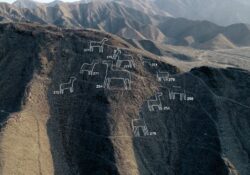A general view shows mapping of the Nazca lines images found in the Nazca as part of research led by Peruvian and Japanese researchers from Yamagata University (Credit: Reuters)
More than a hundred new designs have been discovered in and around Peru’s ancient Nazca plain.
The stunning find could bring new information to light about the mysterious pre-Columbian artworks that have intrigued scientists and visitors for decades.
Following two years of field surveys with aerial photos and drones, Peruvian and Japanese researches from Yamagata University earlier this month reported the discovery of 168 new designs at the UNESCO World Heritage site on Peru’s southern Pacific coast.
The geoglyphs (huge figures carved into the South American desert) date back more than 2,000 years and represent humans, cats, snakes, killer whales, birds and native camalids – animals such as llamas, guanacos and alpacas.
Jorge Olano, head archaeologist for the Nazca Lines research program, said the new figures averaged between two and six meters (6.56 to 19.7 feet) in length. The purpose of the Nazca lines, which could only be seen from the air, remain a mystery.
Researchers discovered 168 new designs at the UNESCO World Heritage site (Credit: Reuters)
This month’s findings, however, are smaller and can be seen from the ground, Masato Sakai, a professor from Yamagata University who led the study, told Reuters.
The figures, iconic vestiges of Peru’s rich history, are about a three-hour drive from the capital Lima.
Many of the designs can only be seen from the sky (Credit: Reuters)
The lines date back thousands of years but were only discovered in the 1930s (Credit: Reuters)
Researchers had already discovered 190 figures in the area since 2004. But the vastness of the terrain they cover has complicated efforts to study and conserve the heritage site.
Yamagata University said the research will be used in artificial intelligence-based surveys to help inform the lines’ preservation.
Studies from the university in collaboration with Peru’s government have helped delineate and protect the area, which is facing threats from urban and economic developments.
One of the new Nazca lines images found in the Nazca plain (Credit: Reuters)
‘Some geoglyphs are in danger of being destroyed due to the recent expansion of mining-related workshops in the archaeological park,’ Sakai said.
Peru’s famous Nazca lines were first ‘discovered’ by archeologists academically in 1927.
Many are so big they can generally only be identified properly from the air.
Experts still don’t know exactly why the lines were created or what they symbolise (Credit: Reuters)
Experts believe the lines, thought to have been made by the removal of rocky black topsoil to reveal light-coloured sand underneath, were used in ritual ceremonies and may have served as messages to the gods.
MORE : Archaeologists open 3,300-year-old Egyptian tomb ‘like Indiana Jones film set’
MORE : Millennia-old archaeological remains could change our understanding of prehistory
Scientists found 168 new designs at the UNESCO World Heritage site on Peru’s southern Pacific coast.





